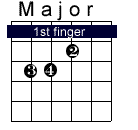The open chords from the previous lesson will get you far, but in some songs, you’ll need to be able to play barre chords as well. See, you cannot play every chord in the guitar’s open position. What if you wanted to play an F or B chord? How about a F# or Gb chord for that matter? You can’t do it without using a barred chord. There are 12 possible major chords and without barre chords you can only play 5 of them. It’s the same thing with minor chords. A barre chord is where we take a basic chord pattern and “move” it up the neck of the guitar to create different chords.
There are four barre chords that I think you should learn. These four shapes will have you prepared to play 98% of all outlaw country songs. They are the E and A major, and the Em and Am, barre chord shapes.
If you don’t already know how to play a barre chord or two, that’s okay, you can practice them over time to master them. You won’t need them for most of the songs in this course anyway. Or you can try the alternate versions that I talk about below.
E Shape Barre Chord


Which Chord Is It?
Depending on the fret your 1st finger barres determines what chord you are playing. For example, in an open E chord the open E string is the root. The E chord barre on the 1st fret is an F chord and so on. This is where learning the names of the frets comes in handy!
A Shape Barre Chord
Fret/Chord Chart
You can determine the name of the chord when the root (lowest) note is played on the frets in the chart below.
| Fret | 1 | 2 | 3 | 4 | 5 | 6 | 7 | 8 | 9 | 10 | 11 | 12 |
| Chord | A#/Bb | B | C | C#/Dd | D | D#/Eb | E | F | F#/Gb | G | G#/Ab | A |
Alternate Fingering
Here is a popular alternative way of playing the A style barre chord. It’s the same form with the exception of the missing note on the high E string. It used a lot because it’s an easier fingering than the full barre chord.


Em Barre Chord Shape

(audio example is F, root on 1st fret of the 6th
string)
Fret/Chord Chart
You can determine the name of the chord when the root
(lowest) note is played on the frets in the chart below.
| Fret | 1 | 2 | 3 | 4 | 5 | 6 | 7 | 8 | 9 | 10 | 11 | 12 |
| Chord | F | F#/Gb | G | G#/Ab | A | A#/Bb | B | C | C#/Db | D | D#/Eb | E |
Alternate Fingering
Here is a poplular alternative way of playing the E minor
style barre chord. It’s the same form with the exception
of the missing notes on the 5th and 6th strings. It is
used a lot because it’s an easer fingering than the full
barre chord. Since we’re just omiting 2 notes we don’t
need a new fret/chord chart, because this pattern is still
basically the same.


Exercise
Play the E minor style barre chord on the first 12 frets
starting on the 1st fret. Listen to this exercise in the
audio example below. You may want to say the names of the
chords as you travel up and down the fretboard to help
you remember them. The exercise is performed in the audio
example below.
Am Shape Barre Chord
(audio example is A#/Bb root on the 1st fret)
Fret/Chord Chart
You can determine the name of the chord when the root
(lowest) note is played on the frets in the chart below.
| Fret | 1 | 2 | 3 | 4 | 5 | 6 | 7 | 8 | 9 | 10 | 11 | 12 |
| Chord | A#/Bb | B | C | C#/Db | D | D#/Eb | E | F | F#/Gb | G | G#/Ab | A |
Alternate Fingering
Here is a poplular alternative way of playing the A minor
style barre chord. It’s the same form with the exception
of the missing note on the 5th string. It is used a lot
because it’s an easer fingering than the full barre chord.


Exercise
Play the A minor style barre chord on the first 12 frets
starting on the 1st fret. Listen to this exercise in the
audio example below. You may want to say the names of the
chords as you travel up and down the fretboard to help
you remember them. The exercise is performed in the audio
example below.
Easy versions
In Mel Bay’s chord book and in many corners of the galaxy this F chord is a major chord shape:

This is, in fact, an F chord, but it is clearly not a basic major chord shape. It is simply a fragment of the E shape barre chord:

The F in the first picture can be used as a barre chord if you find playing the full chord shape difficult. In fact there are alternate fingerings all barre chords that make them more accessible to guitarists, so when your checking out the barre chord lessons I suggested, and run into trouble, try using the alternate fingering versions.




